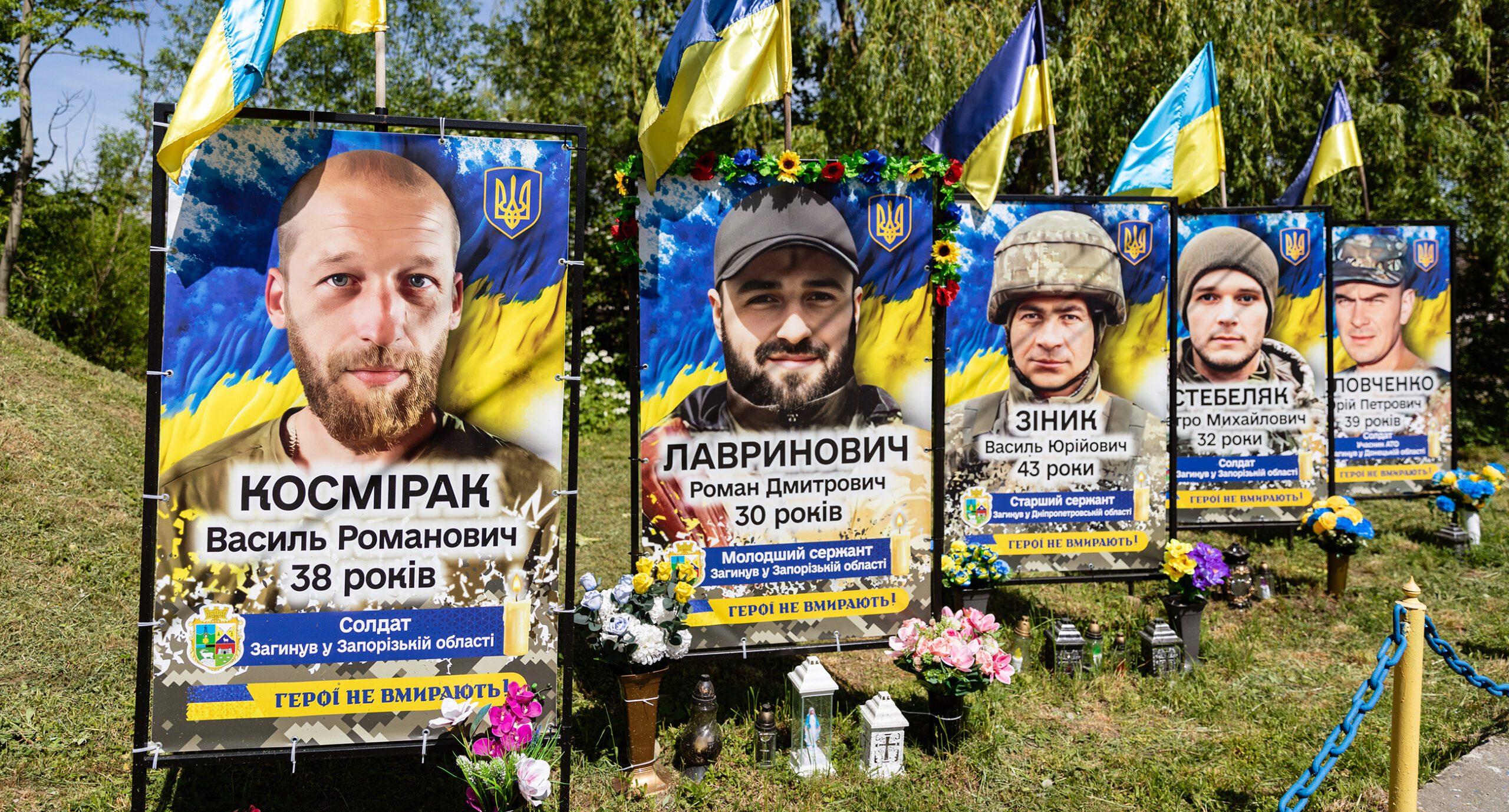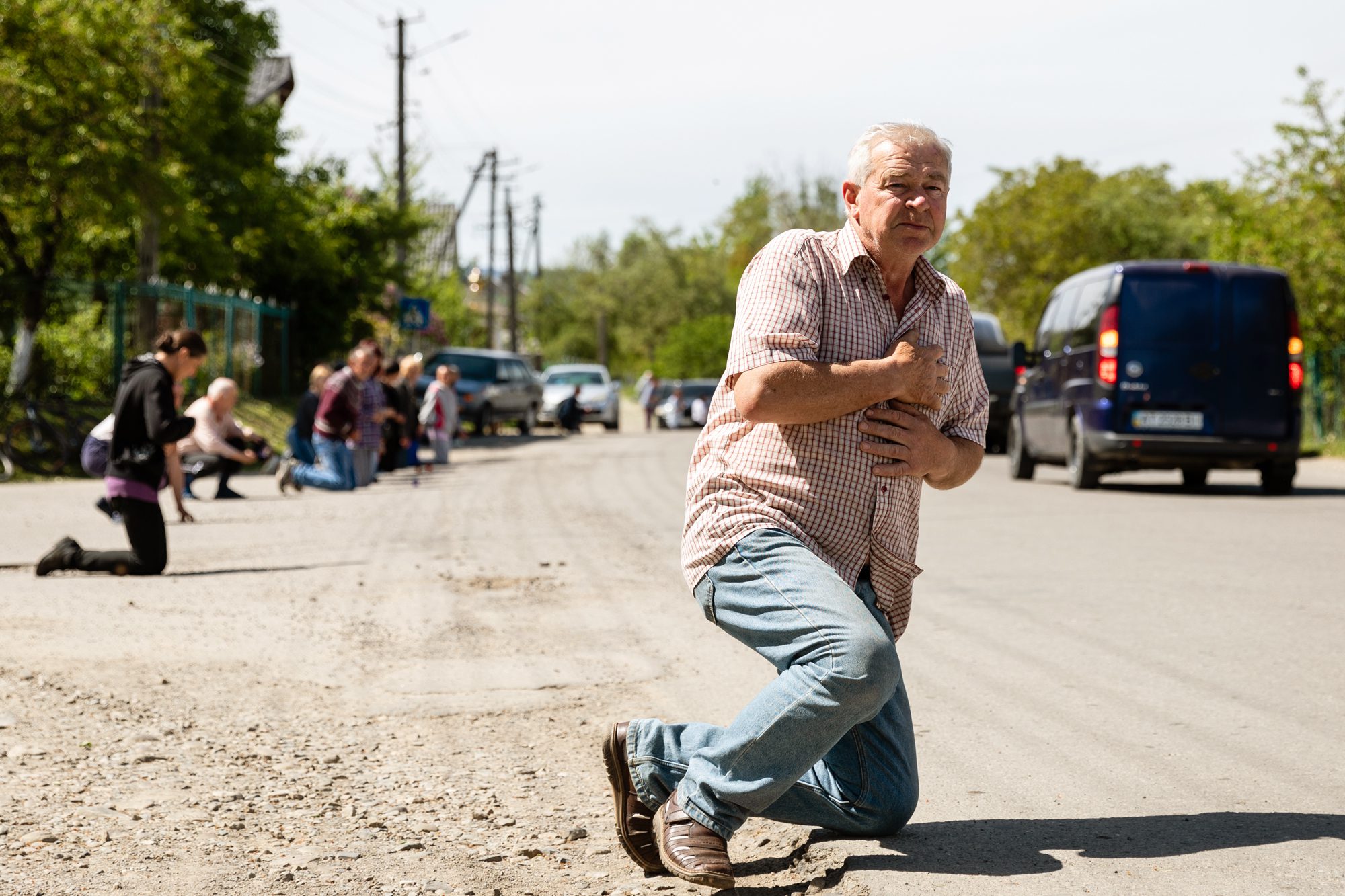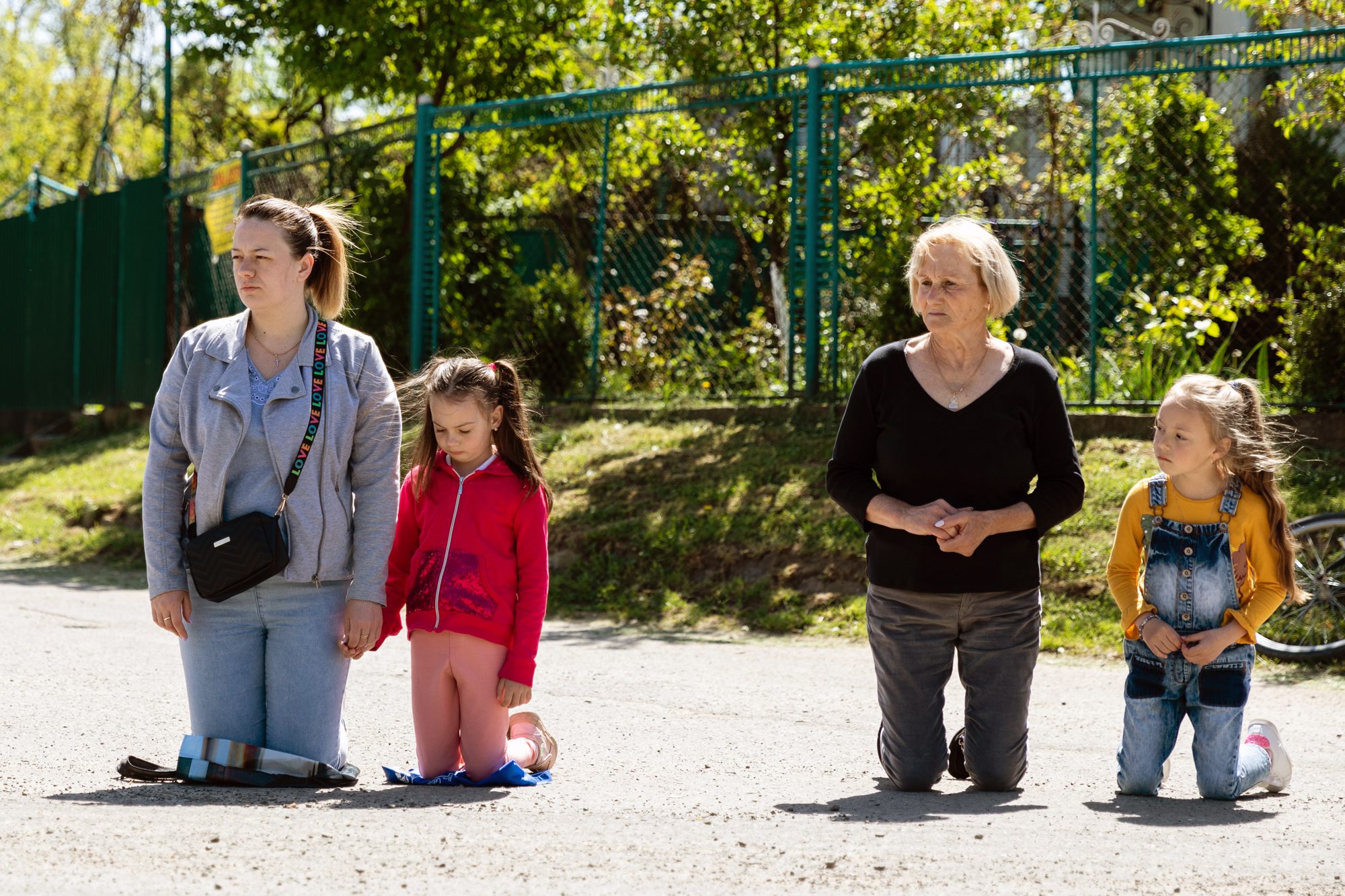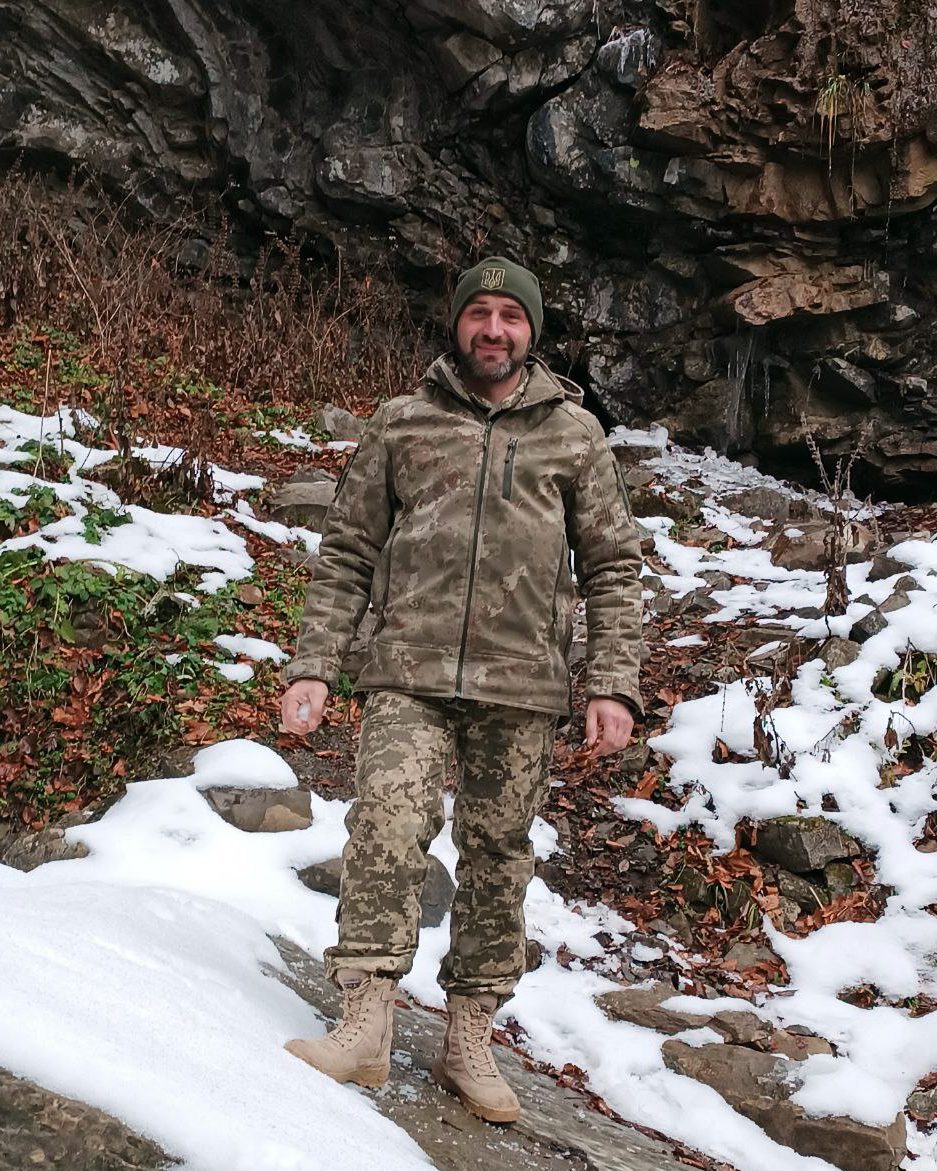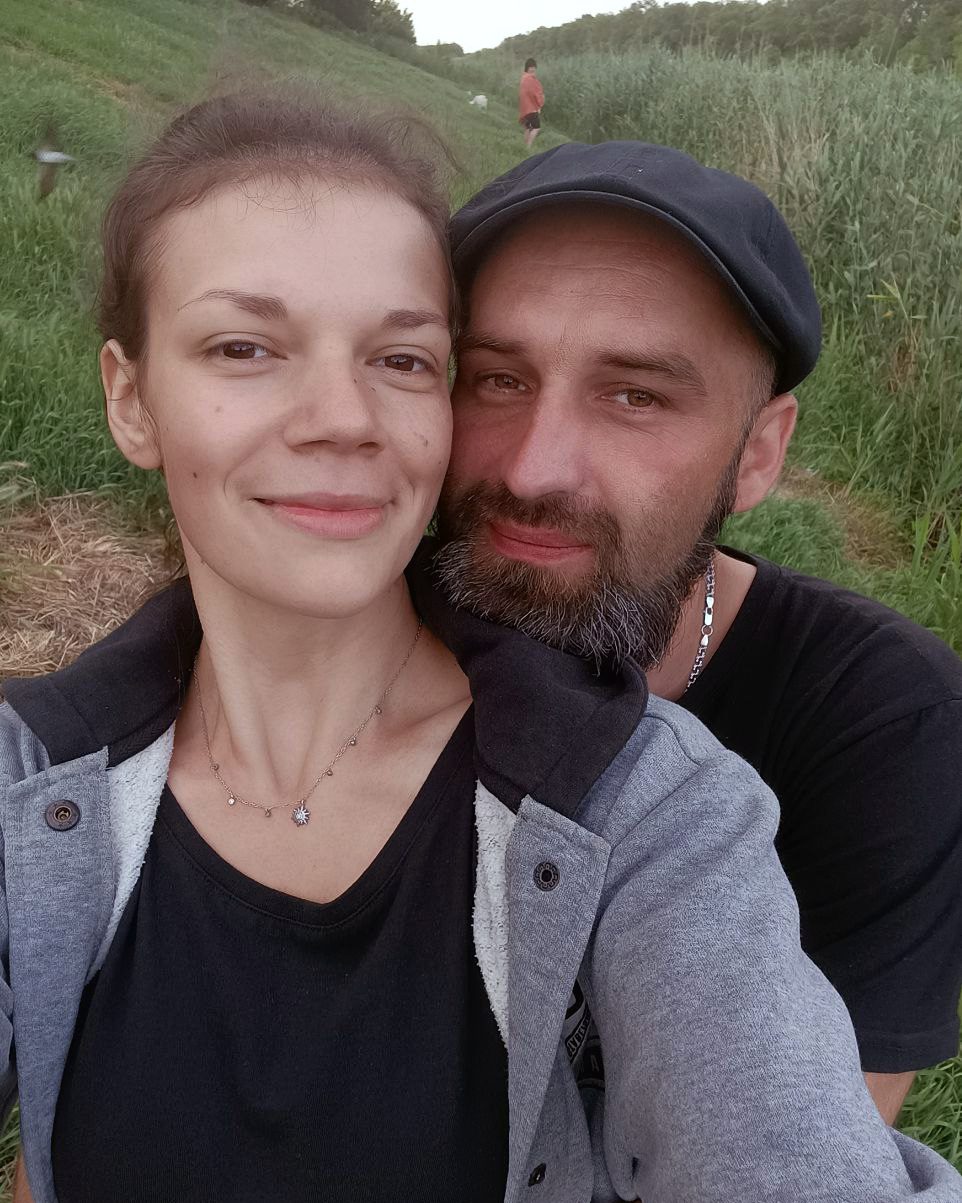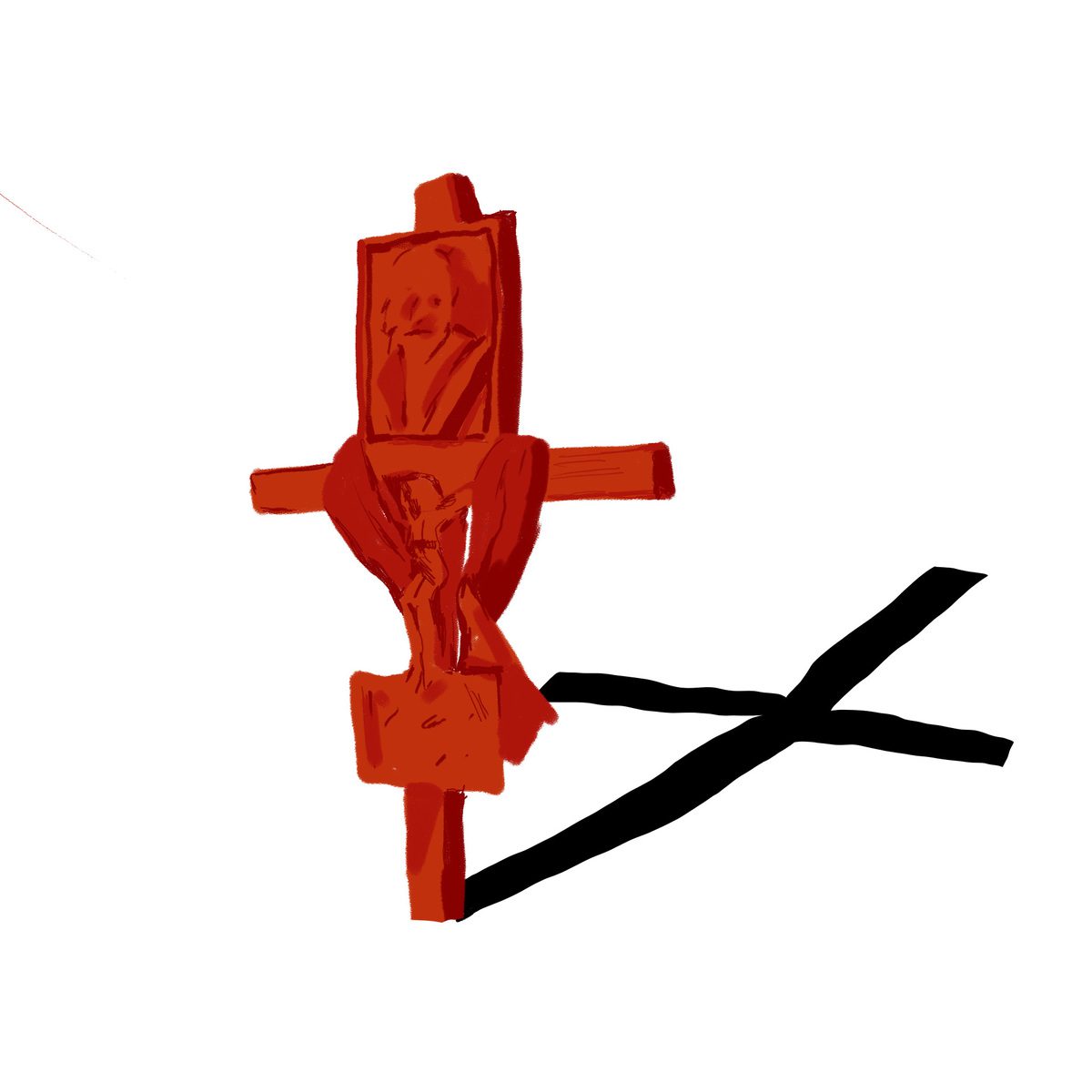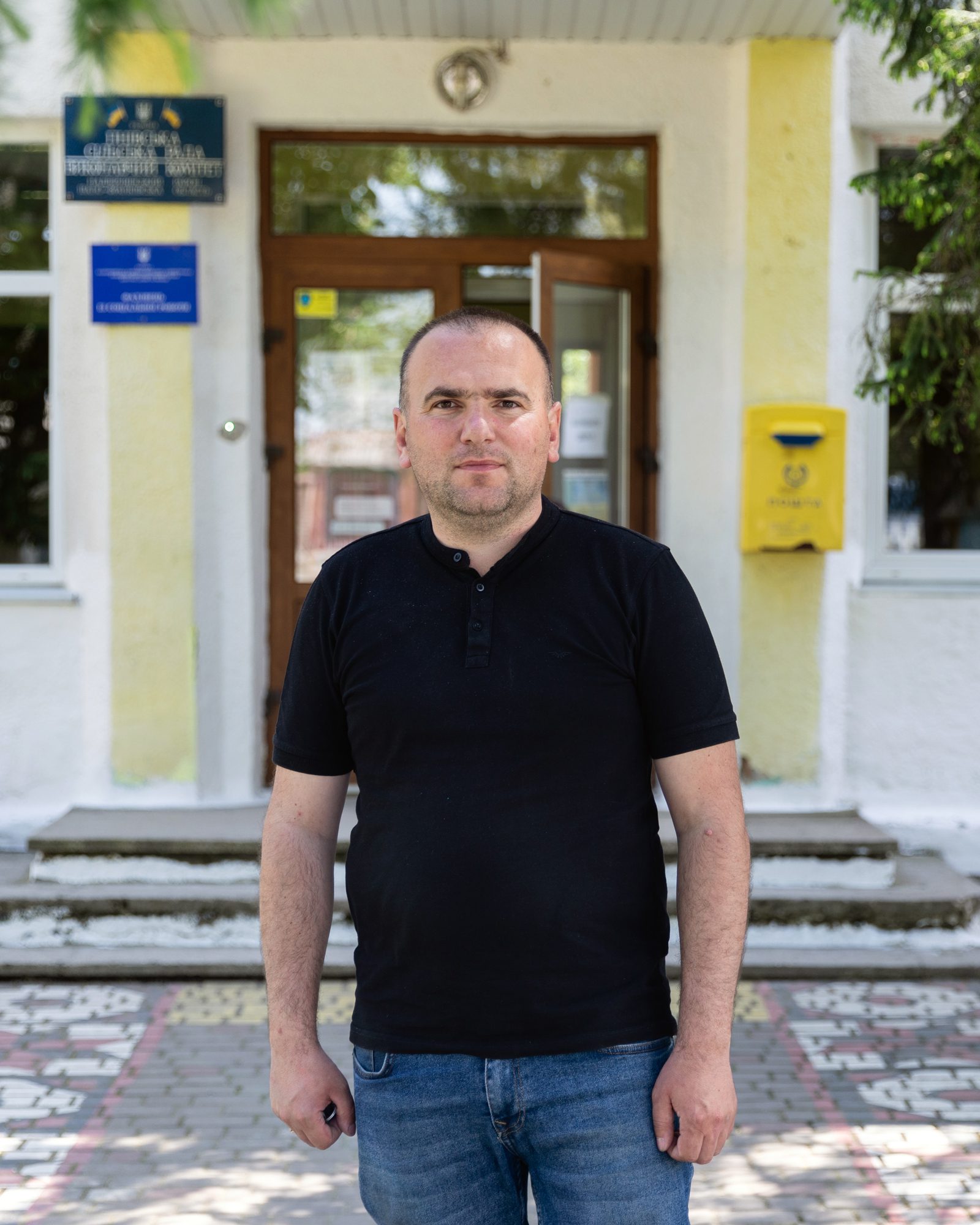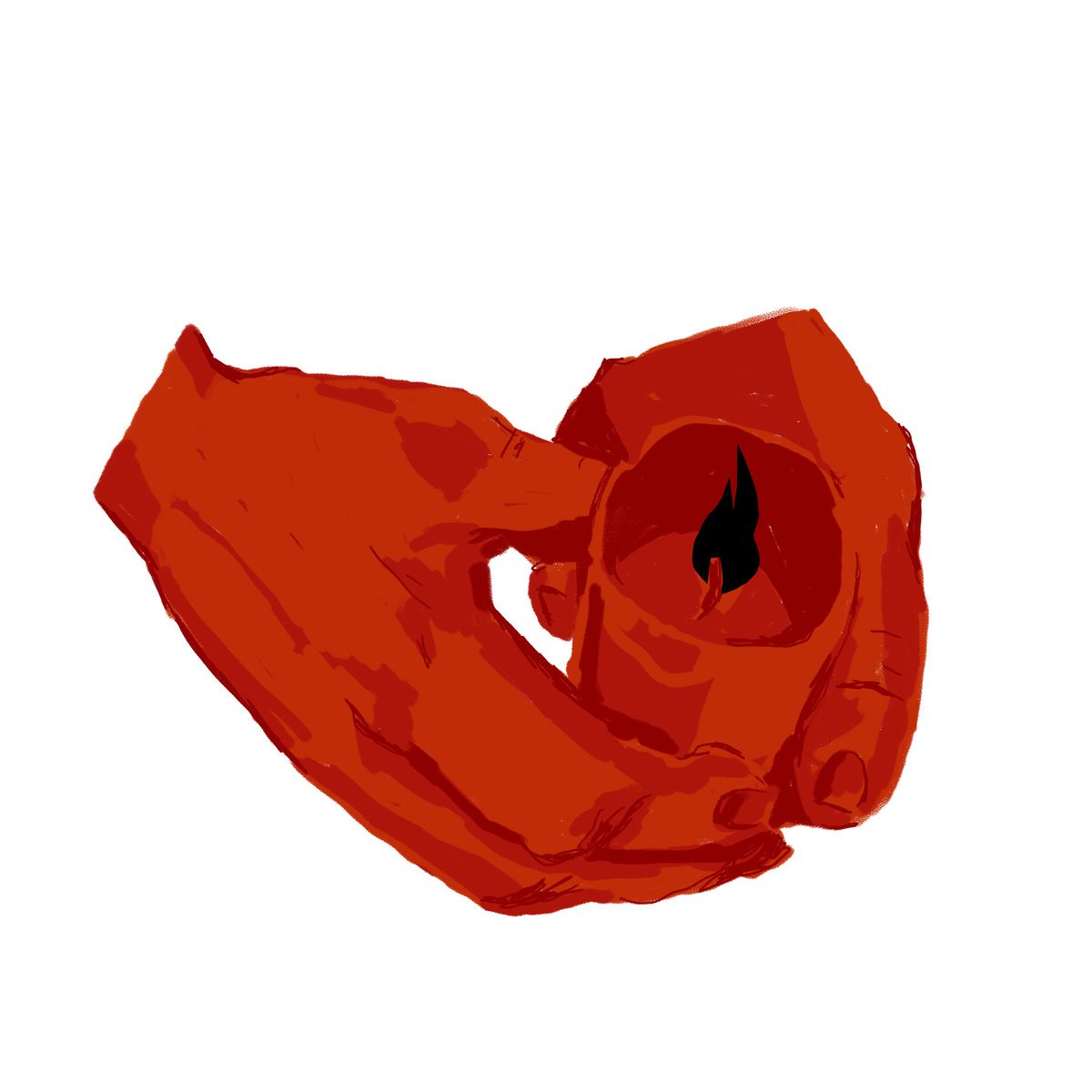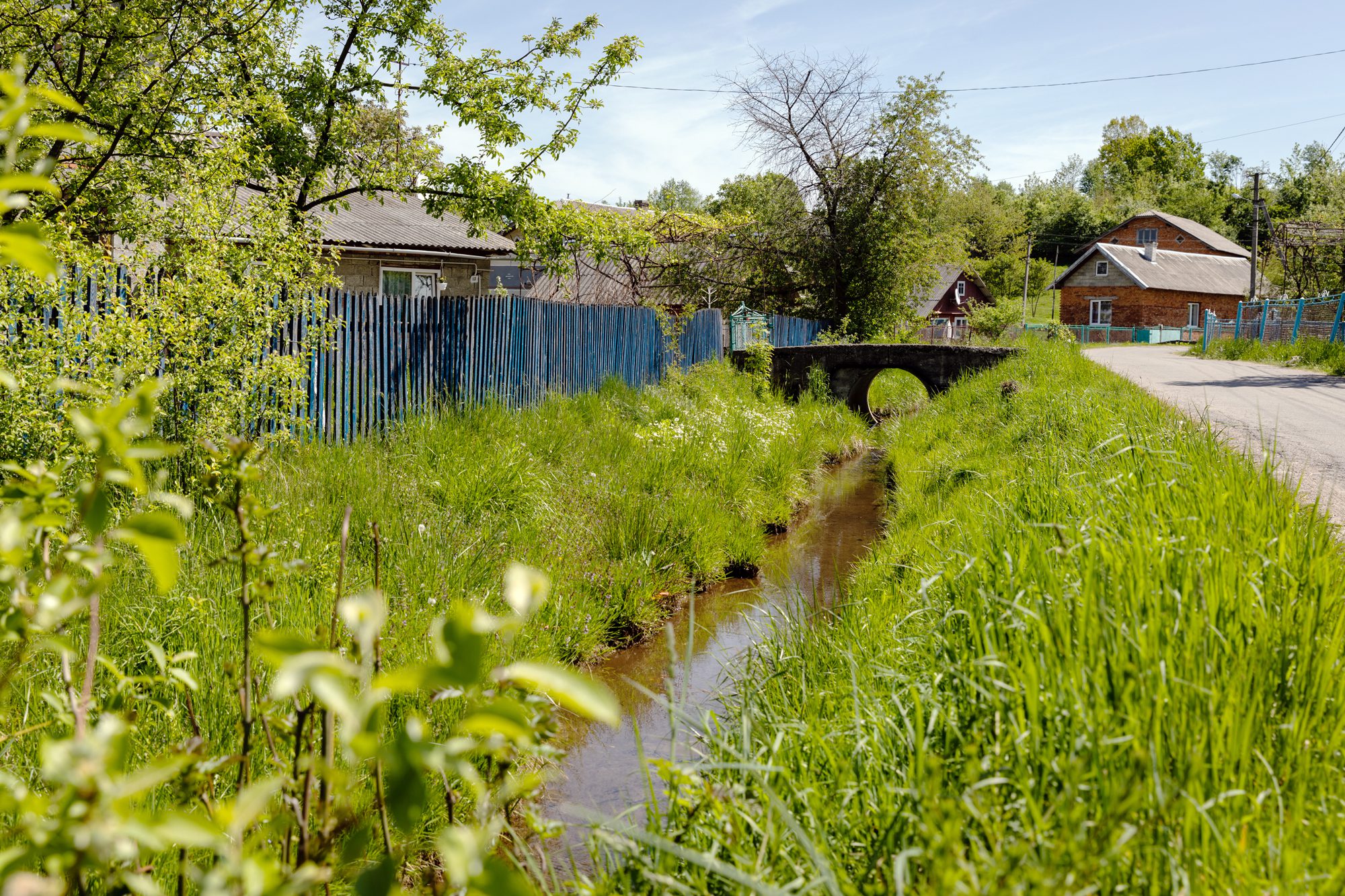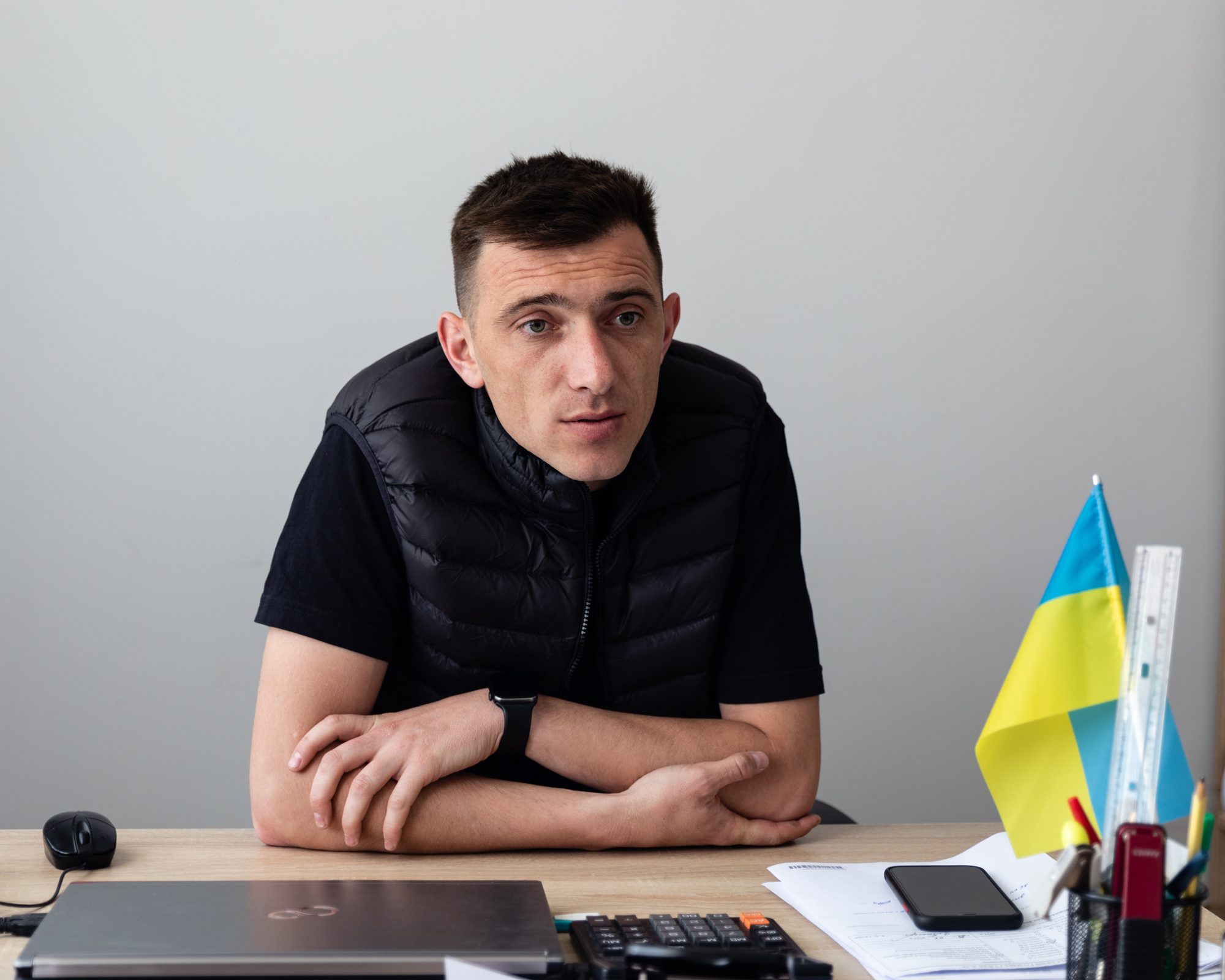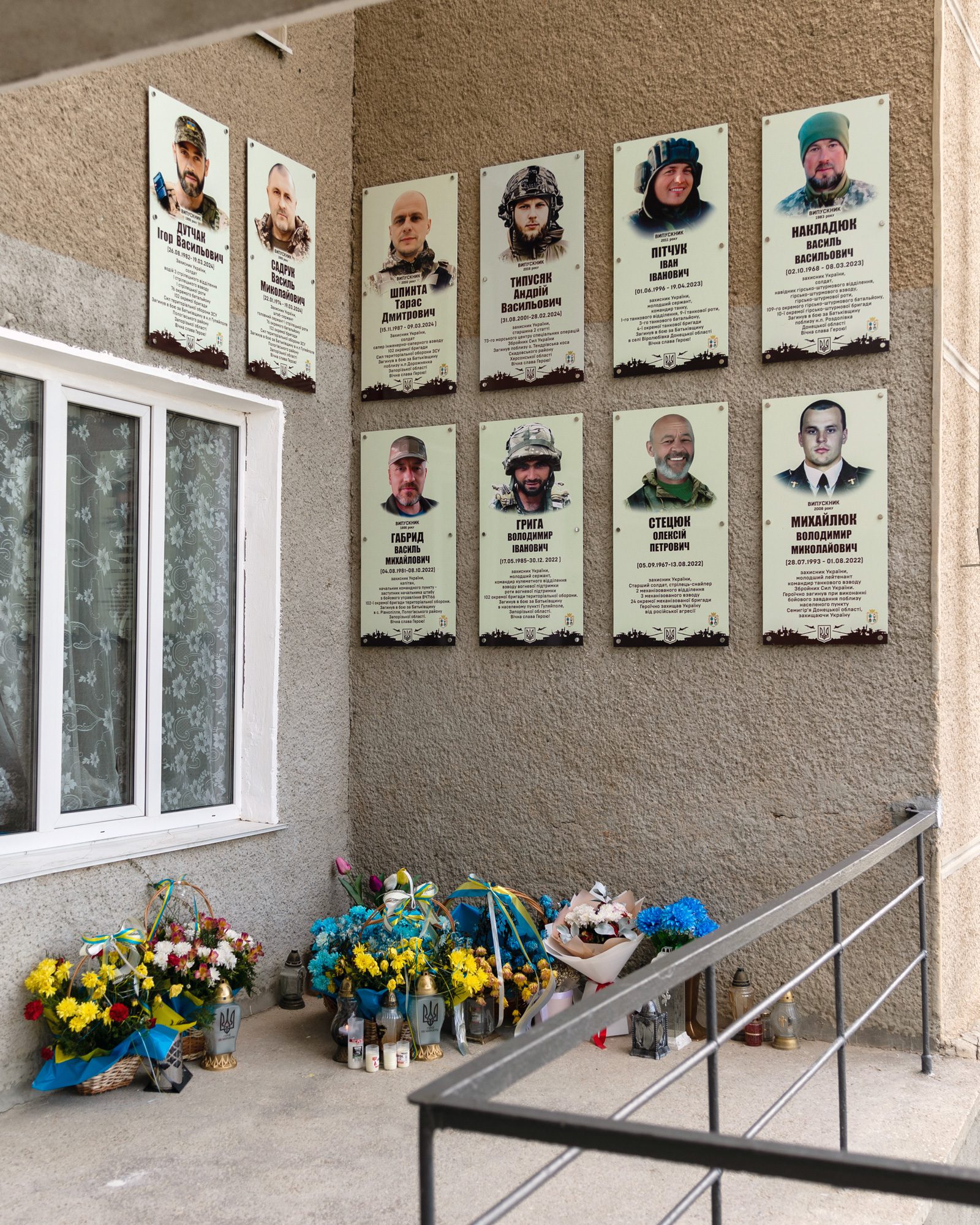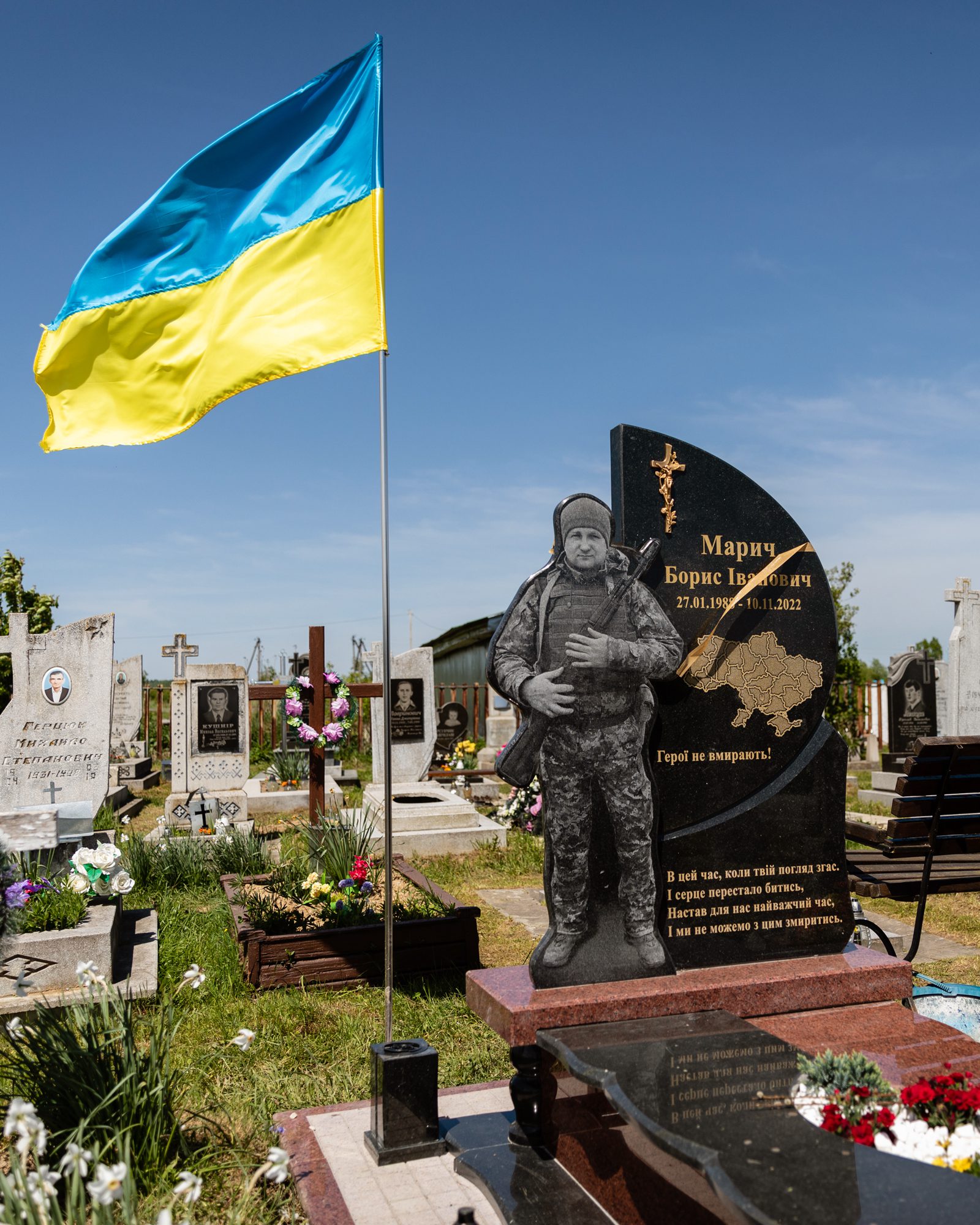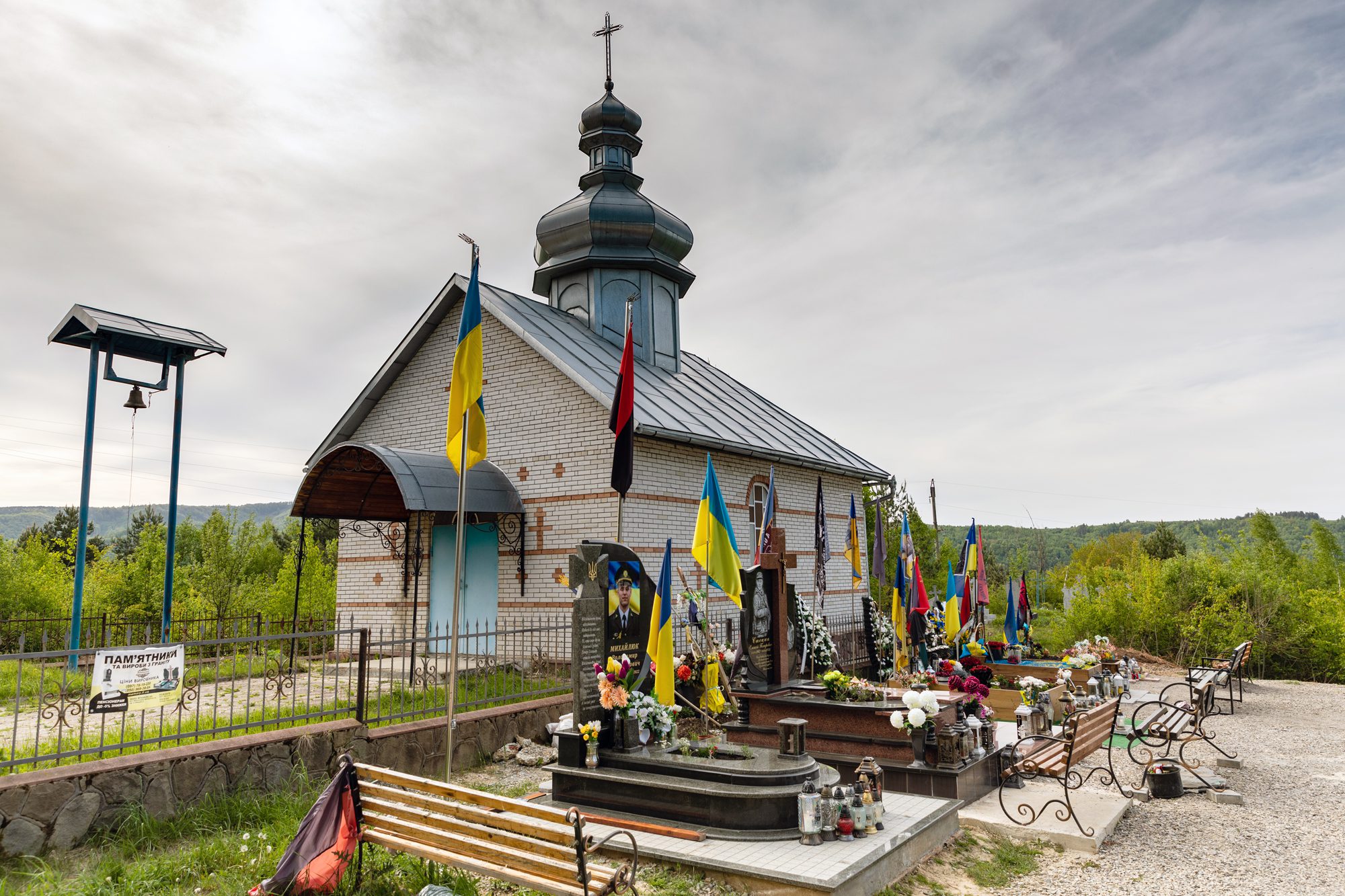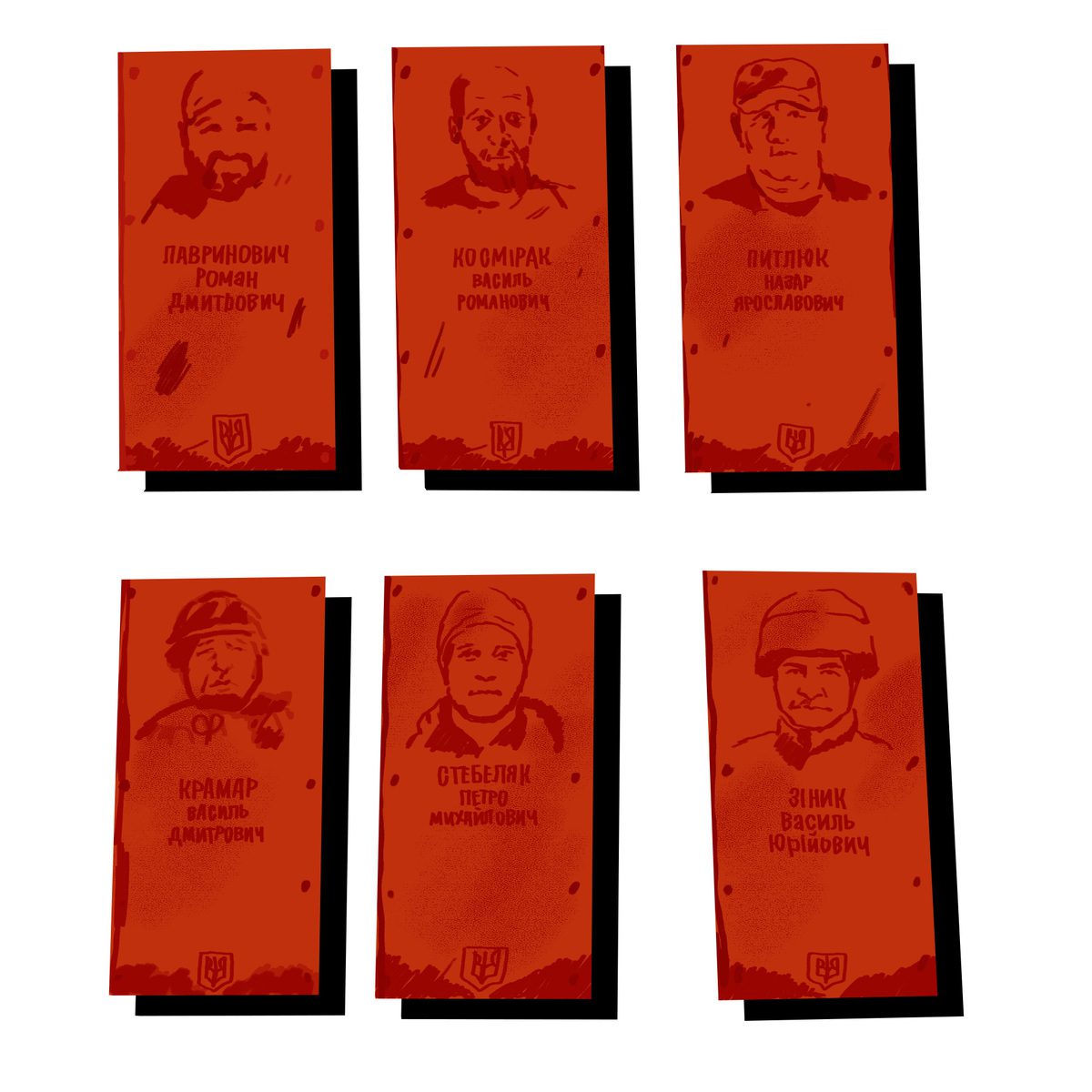A typical Ukrainian village is full of everyday bustle, heart-warming songs, blissful domestic animals, the dizzying smell of bread and home-cooked meals; it is white with flowers in spring and colorful with harvest in autumn; if there’s a wedding, everyone shares the joy, and a funeral is everyone’s loss, too. Now all Ukrainian towns and villages are in mourning. There probably isn’t a single village left that has not buried those who died for their land.
Journalist Eva Raiska and photographer Kateryna Moskaliuk visited a community in the Ivano-Frankivsk region to tell the stories of a modern Ukrainian village tormented by the Great War.
On the shield
Outside, people are slowly lining up along the village road. Women hold black lace scarves in their hands. One of them tries to put a headscarf on, but the wind tousles her gray short hair, throwing the light chiffon over her shoulders. Dressed in warm knitted sweaters, they whisper quietly among themselves. Several men are huddled on the other side of the road, leisurely puffing on cigarettes as the smoke curls upward. The May sun generously throws its rays on the faces of old women as they expose their cheeks to the heat. In their woolen sweaters, in the midst of the blooming spring, they look like Indian maidens, holding colored plastic lamps in their hands, trying to light them. The wind has died down. Now its light blows smooth and level the flickering light that barely smolders from the candles.
The village is drowning in greenery. Gardens with branched alleys diverge in all directions. It smells like lilacs and acacia blossoms. Peony bushes are neatly planted near the houses. One woman, leaning on the balustrade of her porch, watches what is happening on the road through the gate. In a moment, there are a lot more people. Their voices become louder and their gazes more focused. The monotonous gray noise creates a polyphony of sounds. An old woman helps a little boy light a blue lamp by pulling it out from under a purple packet. “They’re here!” someone in the crowd exclaims. People immediately kneel down, some fold their hands in prayer. Today, in the village of Bytkiv, in the Pasichna territorial community of the Ivano-Frankivsk region, the fallen hero is being laid to rest. A black Renault minivan is the first in the convoy. On the car’s windshield is the inscription “On the Shield”, a small flag, and a portrait of the deceased. Behind it are a dozen cars with yellow-and-blue and red-and-black flags flapping in the wind. Someone sobs loudly, gasping for air. Silence falls. Only the birds are trying to drown out the horns of the cars bringing Ruslan Hodziura home with their deafening chirps.

Photo: Kateryna Moskalyuk / Zaborona 
Residents of Pasichna village meet the convoy with the fallen soldier Ruslan Hodziura. Photo: Kateryna Moskalyuk / Zaborona
One pain for all
Mariya Khudak is the wife of one of the fallen heroes of the Pasichna community, Andrii Khudak. She is 27 years old. After her husband’s death, she got a job at the social welfare department of the Pasichna village council, where she is in charge of veteran policy and assistance to veterans and their families. Mariya says that this work allows her to share the pain and sublimate it into helping others — those who have also lost their loved ones to the war. Together with her colleagues, she is primarily responsible for the funeral process, while the village council of Pasichna territorial community takes care of all the organizational and financial needs. She also provides moral support to the mothers and wives of soldiers. The women get together regularly to feel sisterly support and not be alone with their grief. This helps them find the strength to carry on.

Andrii Khudak. Photo courtesy of Mariya Hudak 
Mariya and Andrii Khudak. Photo courtesy of Mariya Khudak
Mariya Khudak recalls her beloved with special tenderness. Mariya and Andrii were born in the village of Zelena, which is part of this community. They lived in neighboring streets. After graduating from university, her husband served in the military in the town of Bila Tserkva. Before the full-scale Russian invasion, he made a living doing various manual labor abroad. On February 24, 2022, Andrii decided to return to Ukraine and fight for his land. In the first days of the great war, he joined the Pasichna territorial defense. A few months later, the defenders were sent to the eastern and southern borders of Ukraine. Andrii fought both in Zaporizhzhia and Donetsk regions. He was the commander of the 1st rifle platoon of the 1st rifle company of the 76th separate battalion of the 102nd separate brigade of the territorial defense.
“And even death will not part them”
“When you love a person, you love everything about them. He had all the best in him,” says his wife Mariya gently. “I have never met someone as kind and sincere as him in my life. He was a man of his word.”
Andrii Khudak died on March 19, 2024, along with two brethren from the Pasichna community, Ihor Dutchak and Vasyl Sadruk. All three were killed in a battle near Huliaypole, Zaporizhzhia region. Ihor and Vasyl had been childhood friends. They grew up together, shared childhood and later adolescent troubles. Andrii Khudak met the guys at the front. They were faithful to friendship and brotherhood to the end, and even death in the war did not part them. Ihor and Vasyl were buried next to each other in the village cemetery of the Pasichna community. There are abundant, fresh flowers near their graves. Andrii was buried in the village of Zelena, where he was born.

Illustration: Kateryna Kruhlyk / Zaborona
In the ranks of the Armed Forces
Before we met him, Andrii Hunda, the head of the Pasichna territorial community, went to get the body of the fallen soldier at the Frankivsk morgue. He does this every time a hero from his community returns home on the shield. Preserving the memory and honoring the fallen Ukrainian soldiers is a priority for both local residents and village authorities. Mr. Hunda personally informs about every funeral procession on his social media, publishing all the necessary information: the time of the funeral cortege’s passage through the village, and the time of the farewell ceremony. It has become a part of everyday life.
In his office, the village head kindly offers us coffee, which one of his colleagues serves in small paper cups with a picture of a Ukrainian Mriya airplane. The man, who is in his late thirties, politely and without unnecessary formality tells us about the life in his community during the war. Without looking into the piles of papers and folders on his desk, he gives us clear statistics about the community’s residents, including those who joined the ranks of the Ukrainian army.

Andrii Hunda. Photo: Kateryna Moskaliuk / Zaborona
Pasichna territorial community covers four villages: Pniv, Zelene, Bykiv, and Pasichna. Since the beginning of the full-scale Russian invasion, 455 people here have been mobilized, of whom 150 have resigned from service due to family circumstances. During the three years of the great war, 37 men from the community were killed and 10 went missing. Two residents of the Pasichna community are still in Russian captivity, while two defenders were released — Azovstal defender Andrii Plitus and Ivan Maikhrovych. Both returned to the ranks of the Ukrainian army. Before the Russian invasion, the Pasichna territorial community had 21,000 residents, now it has 17,000. Of these, 240 men of conscription age continue to fight in the Armed Forces of Ukraine on the eastern and southern borders of the country.
A few days after the conversation with the village head, the news came: Andrii Plitus was killed at the front. In 2022, he and his comrades held the defense in Mariupol at Azovstal and were taken prisoner by Russia. After his release on May 6, 2023, Andrii returned to the army, becoming the deputy battery commander for personnel of the mortar battery of the 2nd Special Forces Battalion.
Andrii was killed near the Serebriansky forest by the village of Dibrova, Luhansk region, exactly one year after his release from captivity — on May 6, 2024.

Illustration: Kateryna Kruhlyk / Zaborona
The bunker of Colonel Grom and Lieutenant of the Ukrainian Sich Riflemen
The village of Pasichna is located in the northeast of Prykarpattia, on the right bank of the Bystrytsia-Nadvirna river valley, surrounded by Horhany massif. A highway passes through the village, and the area itself is a real oil clondike, the second after Boryslav. The history of oil production and the rich oil fields of Prykarpattia were mentioned by Ivan Franko in his novel Boryslav Laughs, where he described the life of the workers of that time. Oil production here began in 1771 and continued until recent decades.
Today, the Museum of Oil Fields of Galicia in the village of Pniv reminds us of the region’s oil past. During the First and Second World Wars, the Pasichna region, like the rest of Prykarpattia, was part of the ZUNR, and later became a place of active struggle for the OUN-UPA. The mountainous landscapes of the village allowed the insurgents to resist and partisan in the local dense forests. The last UPA hideout, or, as it was called, Colonel Grom’s bunker, was located here.
Today, among the monuments that can tell us about those times is the grave of Sofia Halechko, a Lieutenant of the Ukrainian Sich Riflemen. The monument with a bronze bas-relief depicting a woman in a military uniform is located in the Roztoka tract of the Pasichna community. For the locals, Sofia remains a symbol of the Ukrainian spirit. Halechko was one of the world’s first female officers. She was born in Novyi Sącz into a Polish-Ukrainian family, but despite her Polish-speaking surroundings, she chose to serve Ukraine. She became a member of Plast, and during the First World War, she voluntarily joined the Ukrainian Sich Riflemen Legion. At the time, the Ukrainian Sich Riflemen were a Ukrainian volunteer battalion within the Austro-Hungarian Empire and fought against the Russian Empire.

The village of Pasichna. Photo: Kateryna Moskaliuk / Zaborona
Memory
Oleksii Tomyn is 28 years old. He is the head of the culture department of the Pasichna territorial community. Before becoming a civil servant, Oleksii was a musician and had his own band. A saxophone tattooed on his left arm is a reminder of his musical past. The position of the head of culture requires a lot of managerial experience, as well as constant participation in official community events. That’s why there is almost no time for creativity, and even less since the beginning of the great war. When a fallen hero arrives, Oleksii and the village head go to escort the soldier on the shield. In addition, together with his team, he actively helps collect the necessary things for the Armed Forces: military equipment, tile carriers, helmets, cars, drones.

Oleksii Tomyn. Photo: Kateryna Moskaliuk / Zaborona
We get into his old silver Audi and drive to one of the village cemeteries where the fallen heroes of the Russian-Ukrainian war are buried.
There are several such cemeteries in the community. According to Oleksii, the families of the fallen soldiers often want their sons to be buried near their family graves.
However, it is not only the places of eternal rest that remind us of the wounds and pain of war. On the central facade of the Pasichnyansky Lyceum, there are plaques in honor of the former students who died in combat. All the plaques are in the same style: light shades of white and pastel; smiling young faces of the boys, frozen in the blue sky that hangs so still over the roofs. The central windows of the local lyceum are filled to the brim with sandbags, which were placed here in the first days of the full-scale Russian invasion.
We approach the forest, where the place of memory of the heroes is located behind a small mountain. Oleksii confidently steps on the gas, makes a sharp maneuver, and immediately drives up the dirt road to the top of the mountain.

Memorial plaques to fallen soldiers on the wall of a school in Pasichna village. Photo: Kateryna Moskaliuk / Zaborona 
The grave of a soldier in the village of Pniv. Photo: Kateryna Moskaliuk / Zaborona

An alley of honorary burials in the village of Pasichna. Photo: Kateryna Moskaliuk / Zaborona
Blue and yellow flags flutter in the wind, shimmering under the last crimson of the sun. We are slowly moving away from the din of the village, low white huts swarming somewhere behind us. There is complete peace around us, only the rustle of alder trees now and then breaks through the silence of the graves. All the graves here are arranged in a row. There are fresh flowers near each one. The wooden crosses bear the year of birth of the deceased: 1996, 1980, 1960, 1993… Nearby are two graves of comrades who died almost at the same time: Volodymyr Mykhailiuk, 01.08.2022, and Oleksii Stetsiuk, 13.08.22. Forty days ago, three dead soldiers were brought to the village of Pasichna. Two of the heroes were buried next to each other, and the third in the village of Zelena, where he was born. Oleksiy stops near the grave of Ivan Pitchuk, his childhood friend. He recalls how he was always the life of the party, how his presence lit up the others. The Ukrainian defender served in a tank brigade in the Ukrainian Army. He died of a shrapnel wound on April 19, 2023, in the Donetsk region, hundreds of kilometers from home. Oleksii stares intently at the portrait of his friend, immersed in his own thoughts. He is silent for a few minutes and then goes to start the car.

Illustration: Kateryna Kruhlyk / Zaborona
At the entrance to Pasichna, there are information stands with portraits of the heroes and short biographical information. Oleksii Tomyn shows on his smartphone a model of future billboards that the Pasichna village council plans to place in each of the four villages.
We walk to another cemetery in the village of Pniv. A wide panorama of hilly landscapes opens before us. Mountains loom in the distance. This is the most remote place in the village, where the boundary of time intersects: the mundane and the eternal. Blue and yellow flags flutter, once again reminding us of the place of memory of the fallen heroes of the Russian-Ukrainian war.
On the way back to the village, we meet Maria and her grandson, Maksym. It was them we saw lighting a lamp by the roadside, saying goodbye to a fellow soldier of Maria’s son Volodymyr, who continues to fight in the Donetsk region. I ask the woman about her son’s service at the front. She only shakes her head and keeps walking, clutching her grandson to her.
I hear a rooster crowing. Its distant and somewhat lost refrain splashes across the village. Someone is cleaning copper pots outside in preparation for Easter. In the low windowpanes, the snow-white curtains shudder in gusts of wind, as if in alarm. The road is covered in twilight. The day slowly fades into the embrace of the evening.

